Cross-border operations/ 'surgical strikes' by India's armed forces
(→First major use of Cartosat images for Army) |
(→2013/ ? on the LOC (January)) |
||
| Line 31: | Line 31: | ||
==2006/ Myanmar (January)== | ==2006/ Myanmar (January)== | ||
India and Myanmar reportedly conducted joint military operations inside Myanmar, targeting NSCN (K) militants in exchange of transfer of some military equipment to Myanmar Army by India. | India and Myanmar reportedly conducted joint military operations inside Myanmar, targeting NSCN (K) militants in exchange of transfer of some military equipment to Myanmar Army by India. | ||
| + | ==2011-14== | ||
| + | Tactical level strikes were carried out on September 1, 2011, July 28, 2013, and January 14, 2014 | ||
== 2013/ ? on the LOC (January)== | == 2013/ ? on the LOC (January)== | ||
[http://epaperbeta.timesofindia.com/Article.aspx?eid=31808&articlexml=Across-The-Thin-Line-30092016020019 Jyoti Malhotra, Across The Thin Line, Sep 30 2016 : The Times of India] | [http://epaperbeta.timesofindia.com/Article.aspx?eid=31808&articlexml=Across-The-Thin-Line-30092016020019 Jyoti Malhotra, Across The Thin Line, Sep 30 2016 : The Times of India] | ||
| Line 37: | Line 39: | ||
The difference [in 2016 was] that [PM] Modi made a political call to own the cross-LoC strikes. In 2013, no one knew that such a strike had even taken place. | The difference [in 2016 was] that [PM] Modi made a political call to own the cross-LoC strikes. In 2013, no one knew that such a strike had even taken place. | ||
| + | |||
==2015/ Myanmar (June)== | ==2015/ Myanmar (June)== | ||
Indian Army's strike inside Myanmar took 70 commandos and 40 minutes to kill 38 Naga insurgents. | Indian Army's strike inside Myanmar took 70 commandos and 40 minutes to kill 38 Naga insurgents. | ||
Revision as of 07:37, 7 October 2016
This is a collection of articles archived for the excellence of their content. |
Contents |
Covert missions: 1971- Aug 2016

The Times of India
Covert missions carried out by India, The Times of India 30 Sep, 2016
These are some past secret operations conducted by the Indian Army in the neighbourhood.
1971/ East Pakistan
Army closely collaborated with Mukti Bahini inside then East Pakistan in the build-up to the 1971 Bangladesh war. The operation has not been officially acknowledged.
19?? / Kashmir
Indian Special Forces and Ghatak platoons of infantry are known to conduct tactical ops across the LoC in Kashmir to cause small-scale damage and send a strong point across.
1995 Myanmar (Apr-May)
India and Myanmar (then Burma) conducted a joint military operation blocking around 200 NSCN, ULFA and KLO militants moving through the Myanmar-Mizoram border towards Manipur after picking up an arms consignment from Bangladesh.
2002/ Operation Parakram
Indian troops were engaged in limited action across the border a few times, for instance in 2002 during Operation Parakram
2003/ Bhutan
Operation All Clear, conducted inside Bhutan in December 2003 to eliminate Northeastern militant groups. Operation acknowledged by the government. About 30 militant camps, including ULFA, NDFB and KLO hideouts, were targeted, leading to 650 militants being "neutralised".
2006/ Myanmar (January)
India and Myanmar reportedly conducted joint military operations inside Myanmar, targeting NSCN (K) militants in exchange of transfer of some military equipment to Myanmar Army by India.
2011-14
Tactical level strikes were carried out on September 1, 2011, July 28, 2013, and January 14, 2014
2013/ ? on the LOC (January)
Jyoti Malhotra, Across The Thin Line, Sep 30 2016 : The Times of India
[In 2016] none other than former army chief, Gen Bikram Singh, has come on record to say that such strikes by Indian soldiers have taken place in the past as well, including in the wake of the decapitation of two Indian soldiers in January 2013 when Manmohan Singh's UPA was in power.
The difference [in 2016 was] that [PM] Modi made a political call to own the cross-LoC strikes. In 2013, no one knew that such a strike had even taken place.
2015/ Myanmar (June)
Indian Army's strike inside Myanmar took 70 commandos and 40 minutes to kill 38 Naga insurgents.
2016/ Myanmar border (Aug) 'Surgical strike' against NSCN (K)
Rajat Pandit | TNN | Aug 20, 2016, The Times of India 'Surgical strike' inside Myanmar by Army?
- A major gun battle took place between Army troops and suspected NSCN (K) militants along the India-Myanmar border
- The militants fled back into Myanmar leaving some weapons behind
MON (Nagaland): A major gunbattle took place between Army troops and suspected National Socialist Council of Nagaland (Khaplang) militants along the India-Myanmar border, in the Mon district of Nagaland, on Friday. Unconfirmed media reports said at least 30 Indian paratroopers had conducted a "surgical strike" inside Myanmar, and quoted the NSCN-K+ as claiming that it had killed "five to six" commandos. However, Army sources rejected the reports and said the gunbattle took place inside Indian territory .
The fierce encounter took place near Throilu village in Mon district on "our side of the border" at about 5.30am, said Army sources. "Our troops had laid an ambush along a known infiltration route. After the ensuing gunfight, the militants fled back into Myanmar. They left some weapons behind. There were no casualties on our side," said a source.
In June last year+ , days after militants had killed 18 Army soldiers, Indian special forces had conducted a surgical military strike across the Myanmar border to inflict "significant casualties" on the groups behind that ambush, NSCN (K) and Kanglei Yawol Kanna Lup (KYKL). Soldiers of Assam Rifles and NSCN(K) cadres exchanged heavy fire at about 4am near Chenmoho in Nagaland's Mon district, which shares its eastern border with Myanmar, state police said on Friday.
"There was heavy exchange of fire between NSCN (K) cadres and Assam Rifles soldiers. The incident was reported early in the morning. As of now, no casualties have been reported," Yangba Konyak, SP (Mon), was quoted as saying by news agencies. Sources said senior officials had reached the spot for stock-taking. NSCN(K) is a banned militant outfit which last March abrogated a 14-year-old ceasefire with the Centre.
Why covert operations should stay covert
Why these military ops should stay covert by Manimugdha Sharma The Times of India
Surgical strikes in enemy territory have always been kept a secret by Indian forces
Military historian and strategic affairs expert Mandeep Singh Bajwa said he could count at least two dozen instances [between 1947 and May 2015] when India struck inside enemy territory .
“[That is] how militancy in Punjab ended and how it was curbed in Kashmir,” says Bajwa.
1971
In 1971, some very large-scale covert and overt operations were conducted without the Press hearing about it. One of them was Operation Jackpot under which Mukti Bahini commandos were aided and abetted by India to blow up Pakistan's naval assets in the east. This was long before the actual war. “Even before that, there was Operation Windfall where we silently moved two mountain divisions, one towards Balurghat and the other towards Jessore and Khulna. Initially, troops went across in civilian clothes, then in uniform. Pakistanis were completely outclassed and outsmarted by the Indians. That's how wars are fought and won,“ says Bajwa.
The late 1980s, 1990s
“When Pakistan started supporting the Khalistan movement and there were terror attacks on our cities, Rajiv Gandhi decided he had had enough of it. Pakistani cities like Lahore, Multan and Karachi were bombed, which Pakistan claimed were done by RAW . This forced General Zia to sue for peace through the Prince of Jordan and promise withdrawal of support to Sikh militancy ,“ says Bajwa.
His claims are supported by historian Dilip Hiro's 2015 book, The Longest August, which goes on to detail how Benazir Bhutto, after coming to power, promised Rajiv Gandhi that she would totally dismantle the Khalistan support system in Pakistan, triggering the total collapse of the separatist movement.
2000
“Similarly, in Kashmir, terrorism has been curbed through both overt and covert operations. Pakistan blamed India for the 2000 Lanjote massacre, which India denied. But after that, attacks on Hindus in Doda and Rajouri districts stopped,“ says Bajwa.
Uri: Sept 2016 reprisals for attack on
The sequence of events
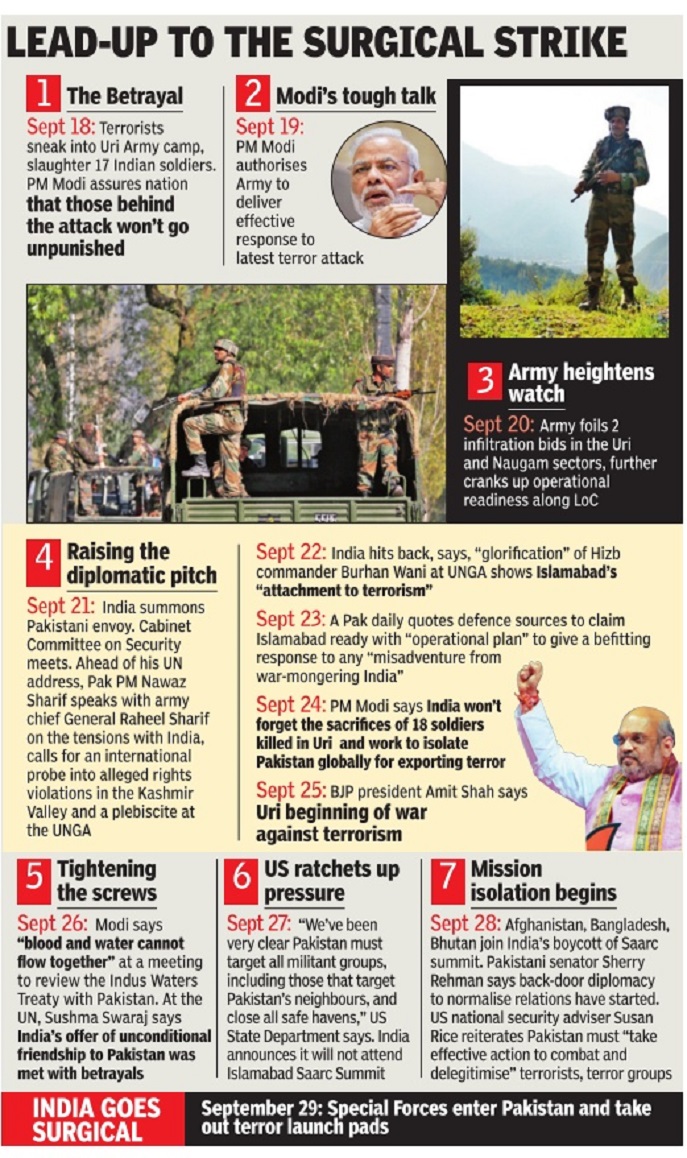
The Times of India

The Times of India
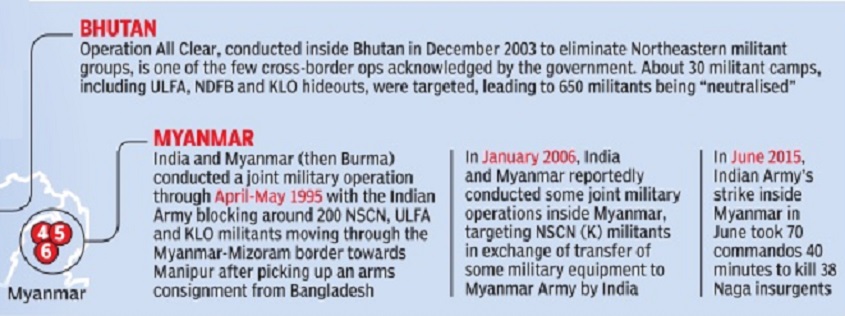
The Times of India
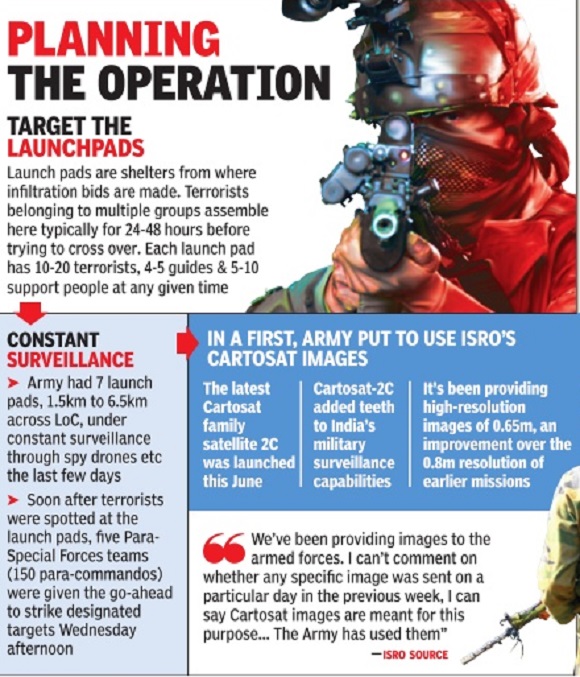
The Times of India

The Times of India
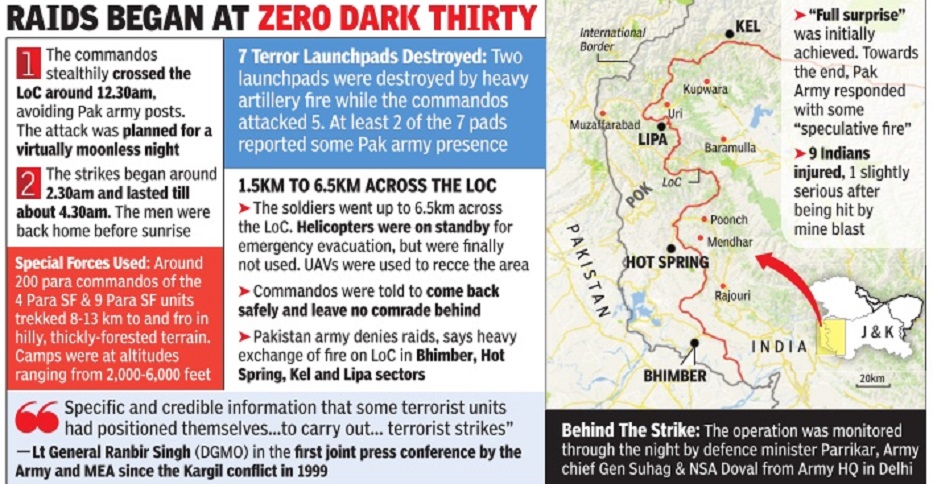
The Times of India
Rajat Pandit, Pak Crossed The Line, India Crosses LoC, Sep 30 2016 : The Times of India
PAYBACK FOR URI: In `Surgical Strikes', Army Hits 7 Terror Launchpads In PoK On A Dim-Moon Night, Kills 40-55
In a stunning reprisal for the Uri terror attack [on Sept 18, 2016], India conducted “surgical strikes“ on seven terrorist “launch pads“ across the Line of Control (LoC) in Pakistan-occupied Kashmir in the early hours of [29 Sept 2016] . Top government sources said that it was “not possible to immediately quantify“ the number of terrorists killed in the strikes carried out by crack Para-Special Forces who simultaneously hit five launchpads located 1.5-6.5 km inside PoK. “According to an initial estimate, as many as 40 to 55 terrorists were killed. But it will take some time to arrive at the approximate number of casualties after the Para-SF teams are properly de-briefed and photographs and videos analysed,“ said a source.
Unlike earlier engagements, the government and the Army boldly proclaimed they had undertaken a big operation across the LoC and justified it by citing an imminent terror threat.
Director General of Military Operation Lt Gen Ranbir Singh along with home minister Rajnath Singh and NSA Ajit Doval told leaders that around 200 soldiers were involved in the operation.
This marked the abandonment of “strategic restraint“: The doctrine which eschewed use of military reprisals for fear of a nuclear conflict and its replacement by a posture of effective military retribution and, more crucially , of pre-emption. It was a stark announcement that the fear of a nuclear showdown has ceased to be a deterrent for India The DGMO justified the action by citing “specific and credible' inputs of terrorist teams positioning themselves at launch pads at LoC “to carry out infiltration and conduct terrorist strikes inside J&K and in various metros“.
Disclosing that he had called his Pakistan counterpart to inform him of the raids, Gen Singh asserted that while the action had ceased, India could undertake similar operations whenever faced with threat to its nationals.
The action came against the clamour for reprisal and mounting pressure on the Modi government to walk its “tough-on-terror“ talk. But while BJP and the government has reason to celebrate, the tough response passed muster with the entire political class, with even opponents who accused Modi government for being `hawkish' applauding the feat of Army and pledging support: a development which could lead to setting of a new benchmark for response to Pakistan-backed terrorism.
The raids, coming a day after Pakistan defence minister Mohammad Khwaja's threat to nuke India, caught Islamabad unawares. It denied the strikes, but soon came around to accept that two of its soldiers had been killed and nine injured in “cross-border firing“. Its different power centres reacted differently, with the Army seeking to downplay the embarrassment, and the civilian leadership warning against more such adventures.
The covert Para-SF raids on the five launch pads were backed by “concentrated fire assaults“ to target two other launch pads -each typically has 10-20 terrorists, 4-5 guides and 5-10 assistants -and three Pakistan army posts across the LoC. The pads are used by terrorists just prior to crossing the LoC and never for more than a couple of days at a time.
After the five teams of 200 commandos from 4 Paras-SF and 9 Para-SF units returned safely after “achieving the desired full impact“ before sunrise on Thursday , Lt-Gen Singh also spoke to his Pakistani counterpart to inform him that the “operations aimed at neutralising terrorists“ had ended.
After UAVs and other intelligence gave “specific and credible inputs“ about the presence of terrorists being positioned at the launch pads kept under constant surveillance for the last few days, the Para-SF teams were directed to spring into action just after “last light“ on Wednesday .Carrying heavy weapon loads, they quietly slipped across the LoC around midnight to finally reach the launch pads by around 3am, skirting Pakistan army posts at altitudes ranging from 2,000 to 6,000 feet, said sources.
The commandos then let loose with all the firepower at their command, finishing their designated tasks by around 4.30am. Nine of them were injured, one slightly seriously in a mine blast. “But they do not leave their comrades behind... all safely made it back to our side before sunrise. Towards the end, Pakistan Army did indulge in some speculative firing but there were no casualties. During the entire operation, the Army and IAF were on high alert for any intervention or extrication mission if the need arose,“ said the source.
Convincing Pakistan’s friends
Indrani Bagchi, How Delhi built its case with Islamabad's friends Sep 30 2016 : The Times of India
India's preemptive strikes across the LoC were more than a military operation. The tightly-scripted action was to rework the framework of engagement with Pakistan, while the overt acknowledgement was necessary for the domestic audience.
The government laid out the ground in the preceding days, briefing key countries about the spike in infiltration and mounting evidence gathered by India including captured terrorists. These included the P-5 countries and key nations such as Saudi Arabia, Qatar and UAE, all Pakistan allies. China was briefed during the Sept 27 counterterrorism dialogue.
The Indian line that the strike came after intelligence pointed to an imminent large-scale strike may have been intended more for the domestic constituency . However, the government expects some degree of retaliation by Pakistan.
The next step was to mount a diplomaticpolitical offensive, which included giving information to the Pak envoy and responding to its invective in the UN.
Modi's Kerala speech lulled people into thinking proactive diplomacy would be all India would do but more robust actions followed this week -cornering Pakistan on Indus Waters Treaty and cancelling the Saarc summit. India is now expected to review the MFN status accorded to Pakistan and restricting Pakistan's use of Indian airspace.
DGMO Lt Gen Ranbir Singh described the strikes as being “along the LoC“ but anybody looking at the targets, terrorist launch pads, is aware they are across the LoC. One of the DGMO's first actions was to inform his counterpart of the strike, clarify it was a oneoff and express sympathy for deaths of Pak soldiers stressing the intent was to go after terror camps. The strike was pitched as a counter-terror op, not a military operation, giving Pakistan reason to resist calls for retaliatory escalation.
After the strikes, national security adviser Ajit Doval called his US counterpart, Susan Rice.The White House readout later said Ambassador Rice “strongly condemned“ the attack in Uri.
Before going public, the government briefed the President, vice-president, former PM Manmohan Singh and the J&K leadership.Foreign secretary S Jaishankar later briefed foreign journalists, 28 envoys, think tanks and TV commentators.
Planning the operation
30 Sep, 2016 Surgical strikes across LoC: Planning the operation, The Times of India
It took the Indian Army 10 days to avenge the terror attack on its Uri camp. This is how events unfolded:
September 18
Terror attack on Uri Army camp, 19 soldiers killed, over 20 injured.
September 20
PM Modi briefed with detailed maps and sand models in military ops directorate with Army chief Gen Dalbir Singh Suhag and Northern Command chief Lt-Gen D S Hooda.
September 27
PM gives go-ahead for surgical strikes after another briefing in MO Directorate.
Constant Surveillance
• Army had 7 launch pads, 1.5km to 6.5km across LoC, under constant surveillance through spy drones.
• Launch pads are shelters from where infiltration bids are made.
• Terrorists belonging to multiple groups assemble here typically for 24-48 hours before trying to cross over.
• Each launch pad has 10-20 terrorists, 4-5 guides & 5-10 support people at any given time.
Cartosat images
• Army put to use Isro’s Cartosat images for the first time.
• Cartosat-2C added teeth to India’s military surveillance capabilities.
• It’s been providing high-resolution images of 0.65m, an improvement over the 0.8m resolution of earlier missions.
'Area of Interest' images
AOI images, which are taken from space and are corrected to a uniform scale, proved useful to the Army.
September 28
Soon after terrorists were spotted at the launch pads, five ParaSpecial Forces teams (150 para-commandos) were given the go-ahead to strike designated targets Wednesday afternoon.
First major use of Cartosat images for Army
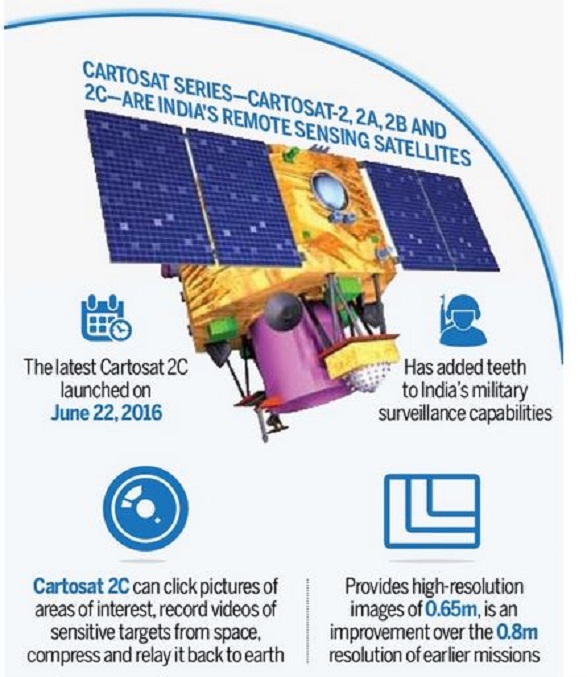
The Times of India
Chethan Kumar | TNN | Sep 30, 2016Surgical Strikes: First major use of Cartosat images for Army
- The surgical strike was facilitated by Isro's Cartosat images
- Cartosat images are called ‘eye in the sky’
- This satellite can click pictures of areas of interest, record videos of sensitive targets from space, compress it, and relay it back to earth
Surgical Strikes: First major use of Cartosat images for Army
BENGALURU: In what's being described as the first major use of the Cartosat family of satellites, the last one (2c) launched in June this year, sources in Isro said that the armed forces were aided by high-resolution images for the surgical strikes+ conducted across the line of control+ (LoC) in the small hours of Thursday.
A source in Isro said: "We've been providing images to the armed forces, the army in particular. While I cannot comment if any specific image was sent on a particular day in the previous week, I can say that Cartosat images are meant for this purpose and the army has used this."
Both Isro and the Ministry of Defence (MoD) have largely remained tight-lipped about the uses of the Cartosat family of satellites—which experts call India's 'eye in the sky'—built for dual use.
The Cartosat-2C in particular added more teeth to India's military surveillance and reconnaissance capabilities, and has been providing high resolution images of 0.65 metres, an improvement over the 0.8m resolution of the earlier missions.
"Cartosat also provided Area of Interest (AOI) based images for the armed forces," the source said. Another explained that based on requests, one or more scenes/images covering the AOI as specified is provided in as a single polygon (all the areas in one circle) in the form of a shapefile (non-topological geometry and attribute information for the spatial features).
According to the National Remote Sensing Centre (NRSC) in Hyderabad, AOI products are of two types—standard and precision-based ortho (where images taken from space are corrected to have an uniform scale—both of which are useful for the armed forces. Ortho rectified products are corrected for terrain distortions and camera tilt effects.
While the first Cartosat was launched in 2005, Cartosat-2A launched in 2007 was the first dual-use satellite with capabilities of monitoring missile launches in India's neighbourhood.
And, the Cartosat-2C is the best in the class that India boasts of although countries like the US and Israel boast of better ones. This satellite can not only click pictures of areas of interest, but also record videos of sensitive targets from space, compress it, and relay it back to earth.
Inadvertent corroboration by POK police
A senior officer of Pakistan police has purportedly admitted that India pulled off a surgical strike across the LoC last week, an Indian TV channel claimed on Wednesday .
According to a CNN-News 18 report, the police officer was given the impression that he was speaking to a senior cop, while actually talking to a journalist, and recorded, as part of a sting operation.
Ghulam Akbar, SP (special branch) of the Mirpur range in POK, reportedly began rattling off details about the events of September 29 and confirmed the claims made by India. “Sir, that was night...you can say roughly 3-4 hours... between 2am and 4 or 5am... the attack continued between that time,“ Akbar reportedly said.
He is heard purportedly confirming that India had struck at terror launch pads in areas, like Leepa, mentioned in reports on the attack. Akbar identifies areas that he “personally knew“ were attacked that night -Samana in Bhimber, Hazira in Poonch, Dudhniyal in Neelam, and Kayani in Hathian Bala.
Akbar is heard stating that the Pakistan army was caught unawares and lost five soldiers, whose names were re vealed but not broadcast by the channel, and that the bodies of an unknown number of terrorists were quickly removed by the Pakistani military . He said Pakistan army personnel put the bodies in ambulances and took them away , adding that many had been buried in villages. He said policemen “are evaluating the coffin boxes“.
The SP added that the Pakistan army cordoned off the aforementioned areas after the surgical strike.
In another revelation that could put Pakistan in a spot, Akbar also purported ly revealed that the Pakistan army facilitated the movement of jihadis in forward areas and arranges for their infiltration into India. “The army brings them, sir...it is in their hands,“ he is heard saying, and that he can't “give accurate numbers because the Pakistan army protects the jihadi infrastructure from even the local authorities and police.